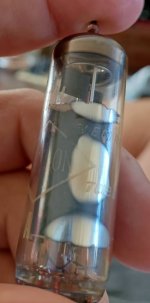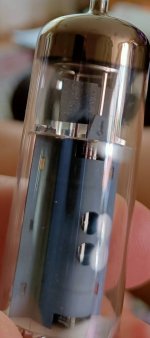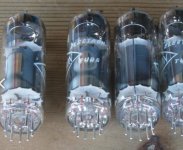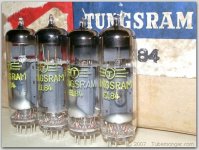I'm no expert but . . .It's been used for a long time. Is that correct? View attachment 959338
Gettering is deposited on the glass when the tube is 'flashed' during the manufacturing process.
It's weird, I've never seen gettering deposited in areas where there is no getter holder - typically a ring or cup of some type. But, if there is some gettering on the side of the tube, in addition to the normal location on the top, it got there during the manufacturing process.
Lots of tubes were designed to have gettering on the sides or even the bottom where it's often difficult to see. Some even have gettering in two locations.
If you're suggesting that the gettering can move within the tube after the tube has been used or that new gettering forms as the tube is used, I don't think that's true.
I would simply test the tube. If it tests new, it should function as new.
Last edited:
I've seen blackened or sometimes brownish deposits in those areas on used tubes. Mullard EL84s, and some other brands / types are known for this. While it does indicate that the tube is used it's not an indication that the tube is bad.Think it is blasted against the glass by electrons. All the material is where there are apertures in the tube. View attachment 959402
But silvery getter material is another thing. I have no idea how it got there but I think it's safe to say that it was deposited there during the manufacturing process and not a result of use.
The tube may be new, lightly used, or heavily used but I don't think the odd gettering pattern tells you anything. How does it test?
That.
It is some kind of *metal* coating, not necessarily "getter material".
There IS an Industrial Process called "Electron beam deposition/sputtering":

a tube may become a similar thing, of course not on purpose but as a side effect.
Notice a plain tube matches much of the above, you have:
* Vacuum
* electron source : cathode
* a crude "crucible" which is any metallic red hot element in cathode or filament construction.
* high voltage difference
* a "target" which in principle is the plate (where "more metal" won´t be noticed) and, through holes as mentioned above: the glass envelope.
As also mentioned above, deposits o glass are usually dark, I have seen brownish or greyish, but a lot of pure metal may produce this mirror finish.
"A lot" meaning anything beyond a few atoms thick
In fact it´s one way of making high quality mirrors, but in this case, on purpose, not as a side effect.
It is some kind of *metal* coating, not necessarily "getter material".
There IS an Industrial Process called "Electron beam deposition/sputtering":

a tube may become a similar thing, of course not on purpose but as a side effect.
Notice a plain tube matches much of the above, you have:
* Vacuum
* electron source : cathode
* a crude "crucible" which is any metallic red hot element in cathode or filament construction.
* high voltage difference
* a "target" which in principle is the plate (where "more metal" won´t be noticed) and, through holes as mentioned above: the glass envelope.
As also mentioned above, deposits o glass are usually dark, I have seen brownish or greyish, but a lot of pure metal may produce this mirror finish.
"A lot" meaning anything beyond a few atoms thick
In fact it´s one way of making high quality mirrors, but in this case, on purpose, not as a side effect.
Last edited:
As the tube was used "for a long time" that is not how it looked when was made , some cathode / filament ( or who knows from where ) material has boiled off and deposited on the glass . This is a usual sight if you work with old TVs . And that tube is at the end of life / weak if you test it . Only some tubes / manufacturers produce that shiny deposits , some produce black stuff or just blackening of the glass , but it is a sign of heavy wear .
Some tubes depending on the manufacturer do have such shiny deposits on glass from new , but for EL84 is not normal . And the deposit patern is not the same for a new / spent tube .
Some tubes depending on the manufacturer do have such shiny deposits on glass from new , but for EL84 is not normal . And the deposit patern is not the same for a new / spent tube .
Last edited:
Similar but not the same, I have seen some old octal tubes in equipment that has seen a lot of lengthy use have a small silver dot straight above the cathode (on tubes with an otherwise clear top), which must have been metal vaporized and deposited from off of the cathode. Curiously, they often still tested well, but these were tubes made during the times before planned obsolescence.
Apparently they are Tungsram made. Someone on AA pointed me to this. They all look like that. Mine say Haltron...but Haltron bought from various manufacturers and printed their name on it.
I guess I'll let them run for a little more and give them a serious listen.
Thanks to all who responded!
I guess I'll let them run for a little more and give them a serious listen.
Thanks to all who responded!
Attachments
Its clearly evaporated cathode that's condensed on the envelope. This might be done in
production to clean/condition the cathode surface, but it might be long term slow evaporation I guess (running the valve too hot?).
As cathode evaporates the emissive coating is likely to be affected, reducing emissivity, and the grid will get contaminated (perhaps becoming a bit emissive, which you don't want).
production to clean/condition the cathode surface, but it might be long term slow evaporation I guess (running the valve too hot?).
As cathode evaporates the emissive coating is likely to be affected, reducing emissivity, and the grid will get contaminated (perhaps becoming a bit emissive, which you don't want).
That is what I would expect. I remember similar silver coatings on old bulbs- obviously emission from the filement. Btw a well known effect limiting their lifetime.Its clearly evaporated cathode that's condensed on the envelope. This might be done in
production to clean/condition the cathode surface, but it might be long term slow evaporation I guess (running the valve too hot?).
As cathode evaporates the emissive coating is likely to be affected, reducing emissivity, and the grid will get contaminated (perhaps becoming a bit emissive, which you don't want).
- Home
- Amplifiers
- Tubes / Valves
- Getter on the side of the tube... Means



